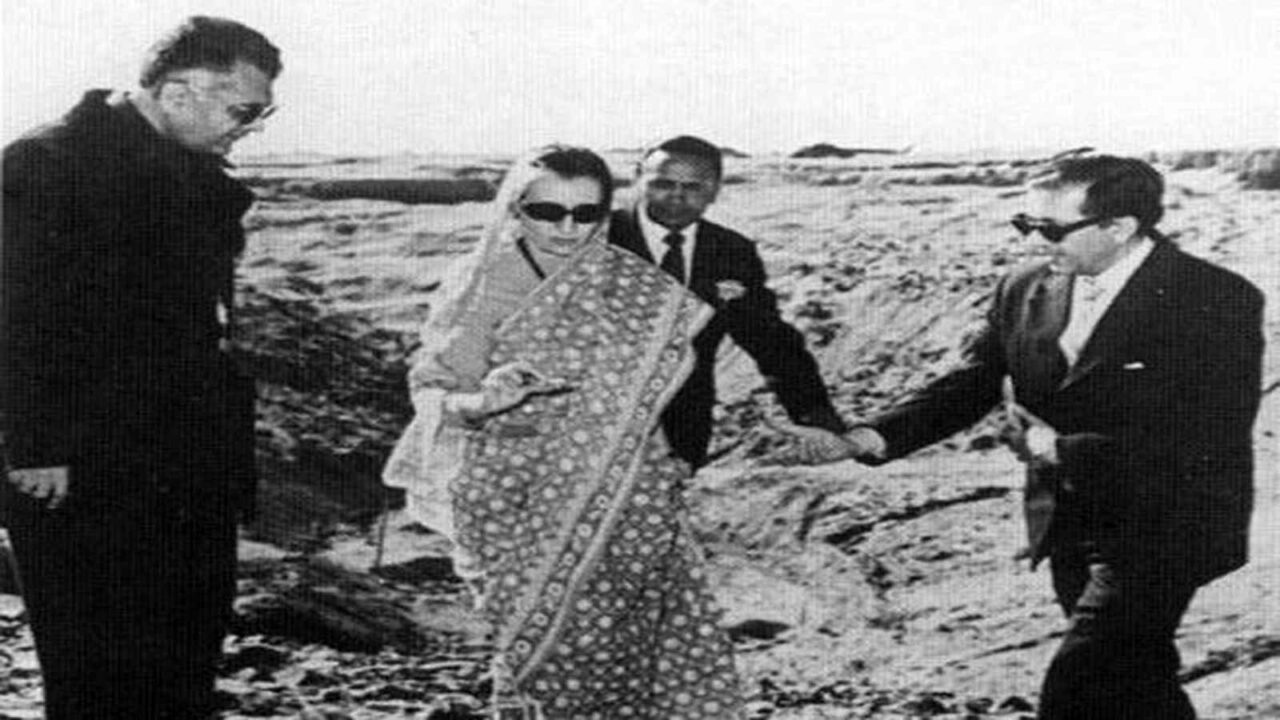Operation Smiling Buddha: On May 18, 1974, India conducted its first effective nuclear bomb test under the codename Operation Smiling Buddha. The Indian Army detonated the weapon at the Pokhran Test Range military base in Rajasthan, under the supervision of numerous senior Indian generals. Due to the fact that India was commemorating Buddha Purnima on May 18, 1974, its first nuclear test was dubbed Operation Smiling Buddha. The former director of the Bhabha Atomic Research Centre (BARC), Raja Ramanna, oversaw Operation Smiling Buddha.
Recent Update
India observed the 48th anniversary of its first nuclear test in Pokhran, Rajasthan, in 2022.
India has adhered to its self-imposed promise not to use nuclear weapons against another nation. Recently, Defence Minister Rajnath Singh stated that India’s prospective NFU (No First Use) commitment may “depend on conditions.”
Nuclear Test Origins of Operation Smiling Buddha
- Following India’s independence from the British Empire, Jawaharlal Nehru approved Homi Bhabha’s proposal to establish a nuclear programme. Due to his contributions to the Indian nuclear programme, Homi J. Bhabha was dubbed “the Father of the Indian Nuclear Programme.”
- Previously, India prioritised benign development because it supported the Nuclear Non-Proliferation Treaty.
- In 1954, after observing the powerful nations strengthen their presence and emphasise their hegemony, India opted out and began devising and producing weapons.
- The establishment of Trombay Atomic Energy in Mumbai and the Department of Atomic Energy (DAE) provided a significant impetus to the development of nuclear weapons in India.
Pokhran-I Nuclear Test and Detonation of the Nuclear Device
- In 1944, Homi Jehangir Bhabha founded the Tata Institute of Fundamental Research, which initiated the nuclear programme.
- After India’s independence, the then-prime minister Jawaharlal Nehru authorised the programme centred on peaceful development.
- From 1954 to 1959, Bhabha shifted the program’s focus to weapon design and production, and research expanded significantly.
- Following Bhabha’s passing, physicist Raja Ramanna supervised all nuclear weapons research and served as the first directing officer of a small team of scientists conducting the tests.
- As soon as Lal Bahadur Shastri became prime minister, he nominated the scientist Vikram Sarabhai to head the nuclear programme, but he steered it towards peaceful objectives due to his Gandhian beliefs.
- In 1967, when Indira Gandhi became prime minister, the nuclear programme was relaunched with renewed vigour.
- In September 1972, Indira Gandhi authorised the Bhabha Atomic Research Centre to construct and test a nuclear weapon.
- The highest command of the Indian Army was kept informed of the test preparations, which were conducted with the assistance of civilian experts under the vigilant eye of the political leadership.
- Technically, the weapon was known as the “Peaceful Nuclear Explosive,” but it was commonly referred to as the Smiling Buddha.
The Nuclear Weapon Explosion
- A nuclear explosion (also known as a nuclear detonation) is caused by the fusion or fission of atoms, which produces an intense discharge or wave of heat, light, air pressure, and radiation.
- The device was of the implosion variety and resembled the Fat Man, an American nuclear weapon that decimated the Japanese city of Nagasaki decades earlier.
India will be a developed nation by 2047: Rajnath Singh
Relevance of Pokhran-I
- The Pokhran 1 tests paved the way for the international recognition of India as more than just a nuclear power. Simply stated, it helped India attain a seat at the global table of importance.
- Due to the limited data set from the 1974 nuclear test at Pokhran, new designs were validated to assure the credibility of nuclear deterrence.
- The establishment of India as a responsible nation with an unblemished record of non-proliferation was of crucial importance.
- India became the sixth country in the globe to conduct a nuclear test after this accomplishment.
- India was the first nation other than the five permanent members of the United Nations Security Council (UNSC) to conduct the Operation Smiling Buddha Nuclear Test, attracting international attention.
Consequences of Operation Smiling Buddha
- Pakistan responded to India’s nuclear test with its own nuclear test. South Asia has abruptly emerged as the nuclear hotspot of the world. Two weeks later, Pakistan responded to international leaders’ pleas for restraint with nuclear explosions.
- Reconciliation with the United States: Following the revelation of the nuclear tests, India launched a massive global outreach campaign, commencing with the United States. They transformed our relationship with the United States and laid the groundwork for reconciliation with the global nuclear system.
- Criticism from the United States The United States Administration criticised the tests, expressed “great disappointment,” and subsequently imposed sanctions on India.
Britain expressed “dismay,” while Germany referred to it as a “slap in the face” to the countries that ratified the CTBT. - The United States imposed economic sanctions while other European nations and Japan suspended assistance.
- Impact on India’s Relations: India’s nuclear tests have had a profound effect on its relations with its neighbours and the rest of the world. Multiple developed nations, led by the United States, imposed sanctions on India out of concern that the Pokhran Nuclear Test could lead to nuclear proliferation.
Pokhran-II
- The purpose of the Pokhran Nuclear Test was to give India the ability to produce fission and thermonuclear weapons with yields of up to 200 kilotons. In response to China’s nuclear capability and Pakistan’s urgent efforts to obtain nuclear weapons with China’s assistance, India decided to conduct nuclear tests.
- The position of India on the Comprehensive Nuclear Test Ban Treaty (CTBT) is also moral. India has stated that it will neither sign nor ratify the current discriminatory CTBT. In contrast, India has pledged to uphold its voluntary and unilateral ban on further nuclear tests.
- The Pokhran 2 nuclear tests were a series of five nuclear weapon tests conducted by India at the Pokhran Test Range in May 1998. Pakistan’s testing immediately followed Pokhran’s explosions.
- India’s policy of hedging ceased in 1998, when it detonated another bomb at Pokhran. Former Prime Minister Atal Bihari Vajpayee announced India’s nuclear status in public.
- India did not join the Non-Proliferation of Nuclear Weapons (NPT) despite playing a crucial role in the discussions, because the obvious inequity was detrimental to our interests. In spite of Western opposition and sanctions, India conducted both peaceful and military nuclear tests in 1974 and 1998, respectively.
- Unlike in 1974, India decided to aggressively develop nuclear weapons, and the United States and Japan imposed economic sanctions prior to the tests. The restrictions were ultimately lifted.
Consequences of Operation Smile Buddha
- After the nuclear tests, Prime Minister Indira Gandhi’s popularity rose after being largely stagnant since the conclusion of the 1971 Indo-Pak conflict, which began on December 3, 1971, and ended on December 16, 1971.
- The increase in her popularity helped the Congress Party’s overall prospects in the Indian Parliament, where it was well received.
- The international community was vehemently opposed to India’s claim that the tests were conducted for peaceful purposes. In response to India’s nuclear tests, the Nuclear Suppliers Group (NSG) was formed to prevent the global spread of nuclear weapons. In 1992, the NSG determined that future nuclear export agreements would require numerous safeguards.
- This resulted in India no longer receiving nuclear exports. As a result of the Indo-US Civilian Nuclear Agreement of 2008, the restrictions were abolished.
- Pakistan never acknowledged India’s claim that the tests were conducted without incident. Pakistan’s prime minister, Zulfikar Ali Bhutto, emphasised that his nation will never submit to Indian nuclear threats or tolerate subcontinental dominance.
- In response to India’s nuclear tests, Pakistan would promptly launch its quest for nuclear weapons. Regardless of the outcome, Operation Smiling Buddha remains one of the most significant events in modern Indian history.
Conclusion
Operation Smiling Buddha was the first nuclear test verified to have been conducted by a nation that is not a permanent member of the United Nations Security Council (UNSC). The precise yield of the Pokhran bomb is unknown, but it is estimated to be between 8 and 12 kilotons of TNT. The most impressive aspect of the exercise was India’s ability to evade detection by U.S. and other intelligence agencies. Although the nuclear test was successful, its aftermath was not favourable for India, as several developed nations, led by the United States, imposed sanctions on India out of concern that the Pokhran Nuclear test could lead to nuclear proliferation. However, this was only the beginning for India, as it led to the 1998 Pokhran-II tests, another successful nuclear testing programme at the same location.
















